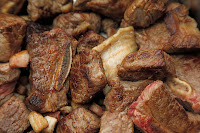 Time in Paris was magical. My most memorable times were shopping for our Christmas tree, Christmas Eve midnight mass at Notre Dame Cathedral, our walk back to the apartment along the Seine and Christmas day dinner – I made Beef Bourgogne from Julia Childs cookbook.
Time in Paris was magical. My most memorable times were shopping for our Christmas tree, Christmas Eve midnight mass at Notre Dame Cathedral, our walk back to the apartment along the Seine and Christmas day dinner – I made Beef Bourgogne from Julia Childs cookbook. I have to say that Julia Child was not afraid of spending too much time in the kitchen. By the time I managed to do all the steps she recommended, dinner was on the table by 8 pm (I started at 10 that morning!). Of course, it always takes longer to make a dish the first time, that’s why I had to make it again.
We’re now back home in Niagara and deep into the madness that is our daily lives. I picked up some stewing beef (and braising ribs - I can't resist, they're delicious!) and the rest of the ingredients at the supermarket and set to work. After I’d finished with the bacon, I began to dry the beef. I set a piece in the hot oil and it began to spit and sputter as it should. I put in another piece, another and another. Soon I had 8 pieces of stewing beef in the skillet when I noticed there was a lot more liquid in the skillet than I’d started with.
 My meat was not browning, it was now boiling. I removed the beef and dried it one more time, pressing down firmly to catch the liquid that was now oozing from each piece. I drained the skillet and returned the meat. It began to brown quickly. Good, dry beef, I’ve discovered, browns in seconds.
My meat was not browning, it was now boiling. I removed the beef and dried it one more time, pressing down firmly to catch the liquid that was now oozing from each piece. I drained the skillet and returned the meat. It began to brown quickly. Good, dry beef, I’ve discovered, browns in seconds.I did have to wipe out the skillet after I’d browned the 8 pieces because a bit more water came out,
 but not enough to warrant another drying. I continued to dry the beef, sear it, remove it, dry it again and finish the browning process – some pieces had to be dried 3 times, but most only 2.
but not enough to warrant another drying. I continued to dry the beef, sear it, remove it, dry it again and finish the browning process – some pieces had to be dried 3 times, but most only 2.So why is it that our Canadian beef has so much water in it? Is it injected to add weight as one customer claimed? Is it not aged long enough? Is it the type of cattle? I don’t know the answer to this but I will soon.
The meal was absolutely delicious! It was far from the rich, velvety, smooth, beefy, ambrosia meal I’d made in Paris with my French ingredients, but it was still very good. The difference was that of a fine, aged red wine at its peak of perfection compared to a quaffable house wine – both are good, but still noticeably different.

We enjoyed our Beef Bourgogne, the meat was more than fork tender – it succumbed to pressure so easily and readily, but interestingly, the tiny little juicy shreds of beef that fell apart were noticeably chewy; a bit unlike the sweet, velvety tender texture of the Parisian meat.
Julia Child’s Beef Bourgogne is so spectacular, so delicious, so amazing that I think everyone should experience it at least once in their lifetime. I would delightfully spend hours in the kitchen if my food tasted this good every time! Besides the seductive flavours, it’s been a lesson in quality of ingredients, and I’m learning about judging quality. This week I’ll make her Beef Bourgogne again, but I’ll go to a butcher shop and chat with him about the beef before I buy. Stay tuned and I’ll let you know what he says.
No comments:
Post a Comment